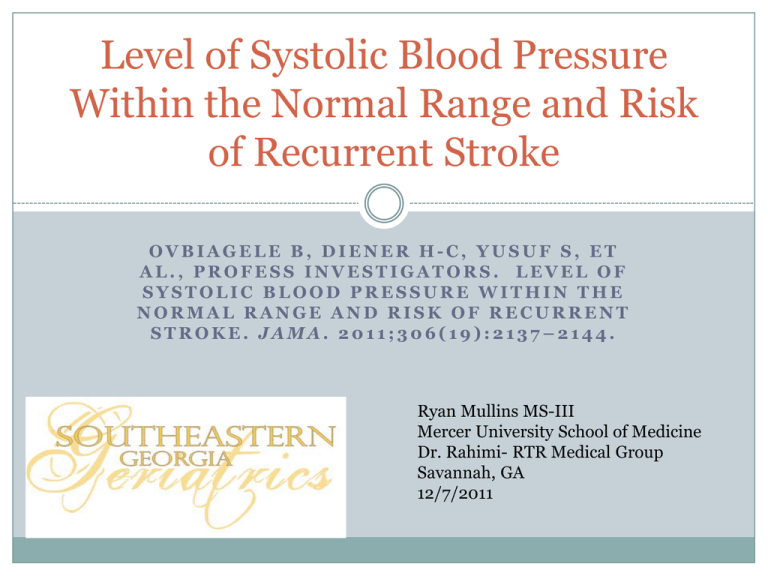
Level of Systolic Blood Pressure
Within the Normal Range and Risk
of Recurrent Stroke
OVBIAGELE B, DIENER H-C, YUSUF S, ET
AL., PROFESS INVESTIGATORS. LEVEL OF
SYSTOLIC BLOOD PRESSURE WITHIN THE
NORMAL RANGE AND RISK OF RECURRENT
STROKE. JAMA. 2011;306(19):2137–2144.
Ryan Mullins MS-III
Mercer University School of Medicine
Dr. Rahimi- RTR Medical Group
Savannah, GA
12/7/2011
Funding
Boehringer-Ingelheim provided grant monies and
materials to execute PROFESS trial, which is the
basis of this post hoc observational analysis
Question/Objective
“To assess the association of maintaining low-normal
vs high-normal SBP levels with risk of recurrent
stroke.”
Design
Study was a post hoc observational analysis of the Prevention
Regimen for Effectively Avoiding Second Strokes (PROFESS) trial.
PROFESS trial included 20,330 patients who had recently had a noncardioembolic ischemic stroke. Patients were enrolled from September
2003 through July 2006 from 695 centers in 35 countries.
PROFESS used 2x2 factorial design to compare (acetylsalicylic acid +
ER dipyridamole) to clopidogrel and compare telmisartan to placebo in
the prevention of recurrent stroke.
Patients were evaluated at the time of discharge from the hospital
(qualifying stroke) or in a clinic visit at one week; then at 1, 3, and 6
months; then every 6 months after. Minimum expected follow-up was
18 months.
BP was measured twice, with at least two minutes between
measurements, using Omron sphygmomanometer, and measurements
were averaged.
Design
PROFESS trial did not find any evidence that (acetylsalicylic
acid + ER dipyridamole) was superior to clopidogrel or that
telmisartan was superior to placebo in the prevention of
recurrent stroke.
Since there were no significant differences found in PROFESS
trial, THIS study combined and included all data from
enrolled patients of PROFESS trial in the analyses for THIS
study following the intention-to-treat principle.
Design
Patients from PROFESS trial were divided into 5 groups based on mean
SBP: very low-normal (<120 mm Hg), low-normal (120-<130 mm Hg),
high-normal (130-<140 mm Hg), high (140-<150 mm Hg), and very high
(≥150 mm Hg).
Mean follow-up and reduction from baseline SBP was measured for
patients using all but their baseline measurements until they died,
experienced an outcome, or were censored.
The group with mean SBP within the high-normal range was the reference
group.
Tests for interaction of baseline features including hx of diabetes, sex, age,
stroke before qualifying stroke, small vessel stroke subtype, large vessel
stroke subtype, and treatment assignment (from PROFESS) were
performed.
Significance level for this study was a P<.05 using a 2 sided test.
Based on comparisons with reference group @ α level of .05, >80% power
to detect a 20% risk reduction in recurrent strokes for the low-normal,
high, and very high SBP groups, and >70% power for the very low-normal
SBP group.
Patients/Setting
Patients in stable condition aged ≥55, or those aged
50-54 with at least two additional vascular risk
factors, who experienced a non-cardioembolic
ischemic stroke within 120 days prior to
randomization.
PROFESS trial enrolled 20,330 patients from 695
centers in 35 countries
Inclusions/Exclusions
Inclusions
None observed other than those listed previously.
Exclusions
Patients excluded if they had a primary hemorrhagic stroke,
severe disability after the qualifying stroke, C/I to any of the
drugs used in the study, or other factors making them
unsuitable for randomization.
Two patients without BP measurements during trial.
Main Outcome
The primary outcome was first recurrence of stroke
of any type.
The secondary outcomes fatal stroke, MI, death from
a vascular cause, death from any cause, and a
composite of stroke, MI or vascular death.
Results
Results
Ovbiagele, B. et al. JAMA 2011;306:2137-2144
Conclusion
The conclusion, based on this post hoc observational
analysis, was as follows: In patients with recent noncardioembolic ischemic stroke, mean SBP levels in
the very low-normal (<120 mm Hg), high (140-<150
mm Hg), and very high (≥150 mm Hg) were
associated with increased risk of recurrent stroke
when compared to high-normal (130-<140 mm Hg)
SBP levels.
Comment
“There were significant interactions between some variables and mean
SBP on outcome in this study, including the association of older age
with more events in the low-normal SBP level group.”
This study was a post hoc observational analysis of a completed
randomized control trial. As such, the possibility that unmeasured
confounding might explain some of the findings cannot be excluded.
The number of patients in the very low-normal group was less than half
the number of patients in all other groups.
Qualifying event for this study was a non-cardioembolic ischemic
stroke, so these findings may not be applicable to cardioembolic
ischemic stroke.
“In conclusion, these data are hypothesis generating and the notion
that aggressively and consistently lowering BP levels within the normal
range in the short term to longer term after an index ischemic stroke is
not beneficial remains unproven, and will require the conduct of
dedicated clinical trials comparing intensive with usual BP reduction in
the stable follow-up period after a stroke.”
Comments
In the study, there were 631 patients without postbaseline SBP
measurements prior to the outcome. For these patients, their baseline
values were used. However, as one can see, baseline values were often
inconsistent with mean SBP groups.
References
Ovbiagele B, Diener H-C, Yusuf S, et al., PROFESS
Investigators. Level of systolic blood pressure within
the normal range and risk of recurrent stroke. JAMA.
2011;306(19):2137–2144.







